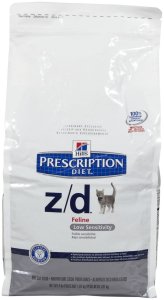I feed Natural Balance Hypoallergenic food what is the difference between that and the Hill’s diet?
Usually when your veterinarian recommends feeding a hypoallergenic diet, it is because we suspect your pet may have a food allergy. The key to diagnosing a food allergy is feeding your pet a novel protein and carbohydrate which your pet hasn’t been exposed to before. This new diet must be fed for a minimum of 30-60 days before results are seen. As you can imagine the key to doing a dietary trial is making sure the diet you are feeding doesn’t contain any trace amounts of other protein or carbohydrate sources. The Hill’s diets are guaranteed to only contain 1 protein and 1 carbohydrate source, where other commercial diets very commonly have traces of other carbohydrate and/or protein sources. Hill’s also has its Z/D diet which has a hydrolyzed protein. A hydrolyzed protein is a conventional protein which is broken down into molecules so small, they don’t stimulate the immune system. The advantage of using a hydrolyzed protein is you take away the guess work of picking a protein source you think the pet won’t react to. For example, if you switch a dog to a venison and potato diet for 2 months and the dog is still itchy after the 2 months, you then wonder if the dog doesn’t have a food allergy, or you wonder if the dog is allergic to venison also. The Z/D diet takes out this variable because the protein molecule doesn’t stimulate the immune system.
is you take away the guess work of picking a protein source you think the pet won’t react to. For example, if you switch a dog to a venison and potato diet for 2 months and the dog is still itchy after the 2 months, you then wonder if the dog doesn’t have a food allergy, or you wonder if the dog is allergic to venison also. The Z/D diet takes out this variable because the protein molecule doesn’t stimulate the immune system.
The other advantage of the Hill’s diet over some other commercial diets is their diets have been tested in clinical settings where other diets may not have been. The way you can tell if a diet has been tested is to look for the Association of American Feed Control Officials (AAFCO) statement on the diet. Diets which have been tested will say under the AAFCO statement that feeding tests have been done, wheres  diets which haven’t been tested will say the diet has been formulated.
diets which haven’t been tested will say the diet has been formulated.
In conclusion diagnosing food allergies can be frustrating for both owners and veterinarians. The key to diagnosing food allergies is trying to eliminate as many variables as possible. The Hill’s diets help us achieve this.


